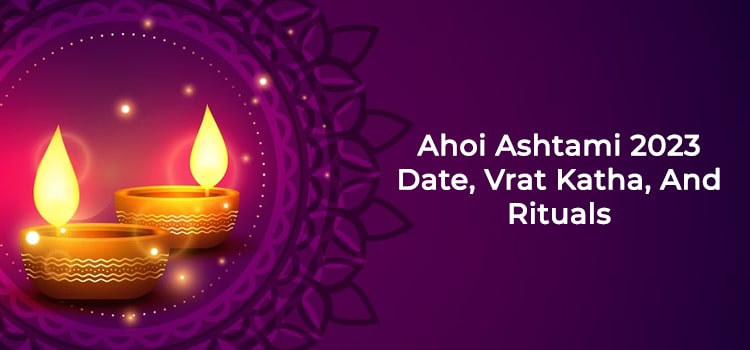Ahoi Ashtami 2023: Date, Vrat Katha, And Rituals
Ahoi Ashtami is an auspicious Hindu festival that falls on the 8th day of Krishna Paksha in the month of Kartik. Ahoi Ashtami honors Ahoi Mata, the Hindu goddess of fertility and motherhood. Hindus worship the goddess for ensuring the well-being and longevity of their children. Women who have children observe a fast on this day, which they break after sighting the stars in the evening sky. After this, they offer prayers and share delicious treats. Women gather together and perform the Ahoi Ashtami Pooja.

On the day of Ahoi Ashtami, mothers observe a strict Vrat/fast from dawn till the sighting of the stars in the evening.
The day prior to Ahoi Ashtami, women clean and decorate the Pooja area with rangoli and flowers.
In the evening, the women come together and narrate the story of Ahoi Ashtami, which is about a mother and her seven sons.
People draw a picture of Goddess Ahoi Mata on the wall using mud or cow dung. Some also embroider it on a piece of cloth and hang it on the wall.
The image of Ahoi Mata used for the Pooja should have Ashtha Koshthak or eight corners, as the festival has an association with Ashtami Tithi. Along with Goddess Ahoi, there will be images of young children and a lion.
Preparation for the Pooja ends by sunset.
Holy water is used to sanctify the place of worship, and Alpana is drawn.
The women spread some wheat on the floor or on a wooden stool.
A water-filled kalash (pot) is kept at the place of worship. Its mouth is covered with an earthen lid.
A small earthen pot (Karwa) is kept on the top of the Kalash. The earthen pot is filled with the water, and it is covered with its lid. The Karwa’s nozzle is blocked with seven shoots of grass. The shoots are usually of Sarai Seenka, a type of willow. People sell these shoots during the festival in small towns. If grass shoots are not available, one can use cotton buds.
The seven shoots of grass are also offered to Goddess Ahoi and the lion.
Women perform a Pooja to Ahoi Mata, seeking her blessings for the well-being and long life of their children.
The food items used in the Pooja typically include 8 Pua, 8 Puri, and Halwa. These are given to a Brahmin along with money. The women offer the goddess traditional food items, including wheat flour halwa and milk.
The women sprinkle water on themselves while reciting the prayers.
After the evening prayer, women break their fast by looking at the stars and moon and drinking water.
The festival is an opportunity for women to gather together, exchange sweets, and share their experiences as mothers.
Elders give their blessings to the children to ensure their longevity and well-being and also give them gifts.
Families pass on the tradition of Ahoi Ashtami to the younger generations, thereby deepening the family bonds and creating a sense of community.
Ahoi Ashtami 2023: Date and Timing
Ahoi Ashtami 2023 is on November 05, Sunday. Hindu mothers celebrate the festival for the well-being of their children. On this day, they fast from dawn till dusk. Ahoi Ashtami comes around 8 days before Diwali. The fasting and Pooja on Ahoi Ashtami are done to please Ahoi Mata or Goddess Ahoi. This day is also called Ahoi Aathe. Ahoi Mata is actually Goddess Lakshmi. Asthami tithi is from November 05, 1:00 am to November 06, 3:18 am. Ahoi Ashtami Pooja Muhurat is from November 05, 5:42 pm to November 05, 7:00 pm.






